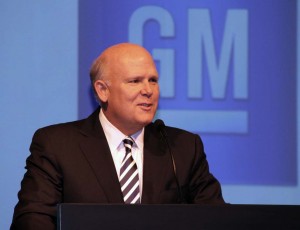General Motors Corp. made a profit of $4.7 billion during 2010, including $500 million in net income during the fourth quarter despite a 25% drop in earnings from its Asian operations and continuing losses in its struggling European automotive business.
GM also confirmed Thursday it will distribute a record profit sharing checks averaging $4,300 to 45,000 hourly workers in the United States. The payments, which will cost the GM about $189 million, are substantially larger any GM has distributed to workers since profit sharing was first included in its union contract in 1982.
“Last year was one of foundation building,” Dan Akerson, chairman and chief executive officer, said, adding that, “Particularly pleasing was that we demonstrated GM’s ability to achieve sustainable profitability near the bottom of the U.S. industry cycle, with four consecutive profitable quarters.
It was the first time GM was profitable during all four quarters of the calendar year since 2004. The maker subsequently ran up about $80 billion in losses before plunging into bankruptcy in May 2009. It emerged from Chapter 11 protection two months later, but only after receiving $49.5 billion in federal assistance.
“We know we still have a lot to do,” Akerson said Thursday during a conference call with analysts and reporters.
GM revenue for the calendar year was $135.6 billion. Automotive cash flow from operating activities was $6.6 billion and automotive free cash flow was $2.4 billion, both reflecting the impact of a $4 voluntary contribution to the company’s U.S. pension plans, GM noted in a statement accompanying the financial report.
Revenues and earnings – the latter adjusted to account for one-time charges – both exceeded industry analysts’ expectations, noted FactSheet.
As a result of GM’s 2010 financial performance, the company will pay profit sharing to approximately 45,000 eligible GM U.S. hourly employees, and approximately 3,000 eligible GM Components Holdings (GMCH) employees. The average payout per employee will be approximately $4,300 for GM employees and $3,200 for GMCH employees, who rejoined GM when the automaker re-acquired plants once belonging to Delphi Corp.
“Our focus for 2011 is to build on our progress and continue to generate momentum in the marketplace. We expect our first quarter will be a strong start,” said Chris Liddell, vice chairman and chief financial officer.
Liddell also noted GM’s unfunded pension liability dropped to $11.5 billion from $16.2 billion.
For the fourth quarter, GM posted $500 million net income, following a $400 million, or $0.21 per share, loss on the purchase of U.S. Treasury preferred shares and $100 million gain on the sale of Nexteer and a manufacturing plant in Strasbourg, France.
GM’s North American operations posted $800 million in earnings before interest and taxes, or EBIT, which was a dramatic turnaround from the $3.4 billion EBIT reported for the fourth quarter of 2009, as the company reorganized following its bailout by the U.S Treasury.
The earnings from GM’s overseas operations dropped during the fourth quarter.
GM Europe had an EBIT loss of $600 million in the fourth quarter, an improvement from a loss of $800 million in the same quarter a year ago. For the year, GM Europe posted a loss $1.8 billion.
Meanwhile, GM International Operations, which reflect the company’s business in China , had EBIT of $300 million, a 25% decline from the $400 million posted in the fourth quarter of 2009.
GM South America had EBIT of $200 million for the fourth quarter, compared with $300 million during the same quarter a year ago. GM began reporting GMSA results as an operating segment in the fourth quarter, and has revised the segment reporting for prior periods.
Jesse Toprak, Vice President of Industry Trends and Insights at TrueCar.com said two factors in GM’s 2010 success were lowering their incentives spending while increasing transaction prices.
“This has been a remarkable year for GM following their emergence from bankruptcy,” Toprak said. “Their recovery has been fueled by significant cost-cutting, arrival of new products that consumers were seeking along with better management of incentives and supply.”
Compared to its competitors, GM outperformed the industry average when it came to increasing transaction price and lowering their incentive spending, he said.

